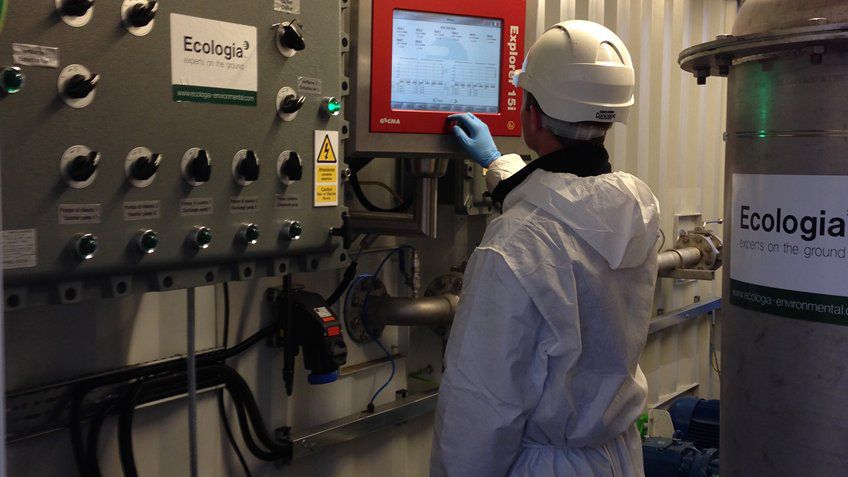Background
In an urgent environmental project, Rockwell Automation®, Cougar Automation, a recognised System Integrator and WIN-911, an Encompass Partner, will all come together in a solution developed by a leading environmental contractor to address a historic ground water contamination.
Ground water contamination is an extremely serious issue and must be dealt with highly effectively to the satisfaction of local environmental standards. Most industrial companies prefer the obvious proactive approach of avoiding contamination in the first instance, but in some cases, accidental discharges are unavoidable and it is in these instances that the specialists have to get involved.
Ecologia, based in Sittingbourne, Kent in the UK, is an environmental contractor whose multi-disciplinary workforce provides specialist advice and undertakes environmental site investigation and remediation projects. Its in-house team of scientists, engineers, chemists and geologists has the expertise required to tackle a wide range of its client's environmental needs. It prides itself on providing the most appropriate solution rather than pursuing a more standardised, less effective approach.
According to Tom Hayes, Director at Ecologia: “We deal with multiple projects involving contaminated land and groundwater, the majority of our work is proactive but, as in this case, sometimes reactive. To give you an idea of the type of issues we deal with, a single teaspoon (5ml) of chlorinated degreasing solvent can contaminate more than an Olympic-sized pool of ground water. The thing is, you don't hear about groundwater much, surface water is always in the news, groundwater is not because you can't see it and it is considerably more difficult to deal with.”
Challenge
The primary challenge faced by Ecologia was not the complexity of the project, but instead, its geographical scale, location and timescale. It involved land remediation and subsequent treatment at a large petrochemical facility in Italy. The multi-phase system will be in operation for a period of approximately three years to remove volatile hydrocarbon contamination in shallow soils and groundwater at the site.
Hayes explains: “The actual technology and know-how behind the project is available to us through our significant in-house expertise, the primary issue we face is the upkeep and monitoring of the facility over such a long timescale. In most instances, this would require one or two full time engineers to remain on site for the entire project duration. It is for this reason that we have been investigating remote automation and telemetry solutions, which releases us from the UK meaning we can export our capabilities and hardware and operate it remotely. In the past you would always have to set up a local office. With good telemetry you don't have to do that – we can do it all from our headquarters in Kent.
“Once we get to this level,” Hayes continues, “we can put our equipment anywhere on the planet and still get regular and timely access to performance data and predictive maintenance information. We are seeing a significant uptake in the deployment of our services, as many multinational companies prefer to work with British, Dutch or US environmental contractors.”
Solution
The project is based upon three identical stand alone systems – at strategic locations on the site – comprising an ATEX-rated HMI running Rockwell Automation FactoryTalk® View SE HMI, Allen-Bradley® CompactLogix™ programmable automation controllers (PAC) and remote access/alarm annunciation via 3G/GPRS modems and WIN-911 SMS software.
Each unit is controlled by a sophisticated ATEX compliant telemetry system developed and tested in house that will allow the equipment to be fully monitored remotely without the need for staff to visit a hazardous part of the site.“The units are undertaking vacuum extraction of contaminated ground water and liquid oil in a very inaccessible part of the site,” Hayes explains. “The contaminating oil is actually spread out on top of ground water to a thickness of 0.5m and will take between two and three years to successfully remove.
“With the hardware we have in place from Rockwell Automation and collaborators we can monitor and change the process remotely,” Hayes elaborates. “We can see what extraction is going on in each individual well and make decisions on the running parameters. Previously we would have to go to site, annually and monitor/change the PLCs, typically over a three day period; we can now do this in less than an hour from Kent.”
The units themselves are 20ft shipping containers, housing high-power pumps the size of a small car. In addition to the pumps, the cabinets have over 40 other components, most of which are monitored by the CompactLogix PAC. Parameters captured include flow rate, temperature, ground water levels, pipe pressures, total fluids (liquid and gas) and the concentration of contaminant in gasses.
“In this instance,” Hayes explains, “the PAC is being used to flag for failures or maintenance related actions such as filter changes; it is purely a process information conduit as opposed to being a process controller. It does have some control function such as those we might see in an emergency, where it can shut down the entire system if, for example, we get contaminated gasses in the stack or if the vacuum pressure is too high.

